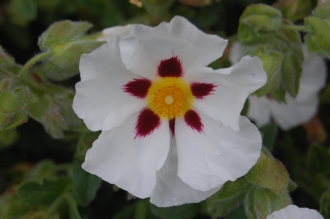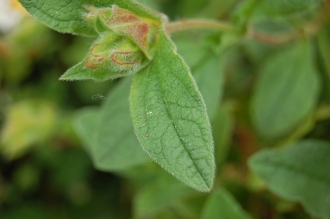Position: Full sun
Flowering period: Summer
Soil: Moist, well drained
Eventual Height: 60cm
Eventual Spread:1m
Hardiness: 8b, 9a, 9b, 10a, 10b
Family: Cistaceae
Cistus ‘Snow Fire’ is an evergreen shrub with a rounded, bushy habit. Its dark green/ grey leaves are lanceolate with entire wavy margins, up to 5cm long and 1.5cm broad. Its white flowers have dark purple and yellow centers, stamens and pistils and are up to 6cm across.
Cistus ‘Snow Fire’, commonly known as Rock Rose ‘Snow Fire’. Cistus ‘Snow Fire’ is synonymous with Cistus albidus ‘Snow Fire’.
The etymological root of the binomial name Cistus is derived from the ancient Greek name for the plant.
The landscape architect may find Cistus ‘Snow Fire’ useful on poor, dry soils or as part of a Mediterranean planting scheme. Once established this plant is drought tolerant. This shrub is not attractive to deer.
Ecologically, Cistus ‘Snow Fire’ flowers are attractive to pollinating insects, including butterfly.
The Royal Horticultural Society has given Cistus ‘Snow Fire’ their prestigious Award of Garden Merit in 2002.
Cistus ‘Snow Fire’ prefers moist, fertile, well-drained soils. It tolerates most pH of soil, although very chalky soils may make this plant become chlorotic. It will tolerate stony very well drained, poor soils. It will not tolerate water logging.
Cistus ‘Snow Fire’ requires little maintenance. Pruning should be carried after flowering, old wood should not be cut.
![]()
Landscape Architecture











